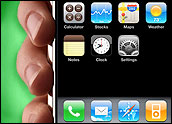
Your Apple device is full of sensors. The main five consist of a proximity sensor, an ambient light sensor, an accelerometer, a magnetometer and a gyroscopic sensor. Also included in these devices are radios, which aren’t strictly sensors but which include the GPS for location services.
In this week’s All Things Appy, we take a look at the five best free apps you can get in order to play with your sensors and sensor-like radios — some of the key features, in other words, that distinguish smartphones from dumb ones.
About the Platform: Apple’s apps can be found in the iTunes store. Browse to the store from your device and search for the app you want to download.
No. 1: Commander Compass Lite

Commander Compass Lite is rated 4 1/2 stars out of a possible 5 for all versions based on 4,429 ratings, and 4 1/2 stars out of 5 for the current version based on 895 ratings in the iTunes App Store.
![]()
This compass app takes advantage of the magnetic compass magnetometer that’s included in recent iPhones and iPads to display directional navigation data — just like a handheld compass. Position, bearings and speed are tracked.

Heavily magnetic fields can interfere with magnetometer readings, so this app starts using a gyroscopic rotational sensor to compensate for that, as well.
No. 2: Planets

Q Continuum’s Planets is rated 3 1/2 stars out of a possible 5 for all versions based on 53,222 ratings, and 4 1/2 stars out of 5 for the current version based on 223 ratings in the iTunes App Store.
![]()
Here’s an app that takes advantage of the gyroscope sensor. Gyroscopes track localized movement of a device.
Planets is a 3D planetarium-style guide to the solar system. Once the device locks onto a location using GPS or cellular towers, movement of the device maps the planets and stars on the screen with the gyroscope in real time.
No. 3: AccelMeter – 3D Vector Accelerometer

AccelMeter is rated 3 stars out of a possible 5 for all versions based on 269 ratings, and 3 1/2 stars out of 5 for the current version based on 16 ratings in the iTunes App Store.
![]()
Whether you knew it or not, the accelerometer is the sensor that orients the phone screen between landscape and portrait — you’ve likely been using your device’s accelerometer daily when Web browsing, looking at photos and controlling any games.
Peter Breitling’s AccelMeter is the best app for visualizing and measuring actual acceleration. It includes all of the three axes — often labeled x, y and z — plus reverse acceleration and g-force calculations.
No. 4: Dimmer
Dimmer is rated 3 stars out of a possible 5 for all versions based on 272 ratings, and 3 stars out of 5 for the current version based on 155 ratings in the iTunes App Store.
![]()
The light sensor on your iPad or iPhone automatically adjusts screen-brightness levels based on what the Apple programmers think should be optimum brightness — based on ambient light. Well, that may not be what you think, and this app lets you adjust sensors manually.
Be aware that a dim screen will save power, while a brighter screen makes small screens more readable.
Sleep therapists reckon a burst of light at night fools the brain into thinking it’s waking-up time, so use a super-dim screen if you’re an insomniac workaholic.
No. 5: Sensor Monitor
Sensor Monitor is rated 4 1/2 stars out of a possible 5 for all versions based on 24 ratings, and 4 1/2 stars out of 5 for the current version based on 11 ratings in the iTunes App Store.
![]()
Here’s an app that lets you display and log raw sensor values for the accelerometer, gyroscope, compass, GPS, battery, microphone, touch and proximity sensors.
The proximity sensor is the sensor that deactivates the display when the phone is in a call so you ears don’t dial phone numbers.
Want to Suggest an Apps Collection?
Is there a batch of apps you’d like to suggest for review? Remember, they must all be for the same platform, and they must all be geared toward the same general purpose. Please send the names of five or more apps to me, and I’ll consider them for a future All Things Appy column.
Don’t forget to use the Talkback feature below to add your comments.





















































